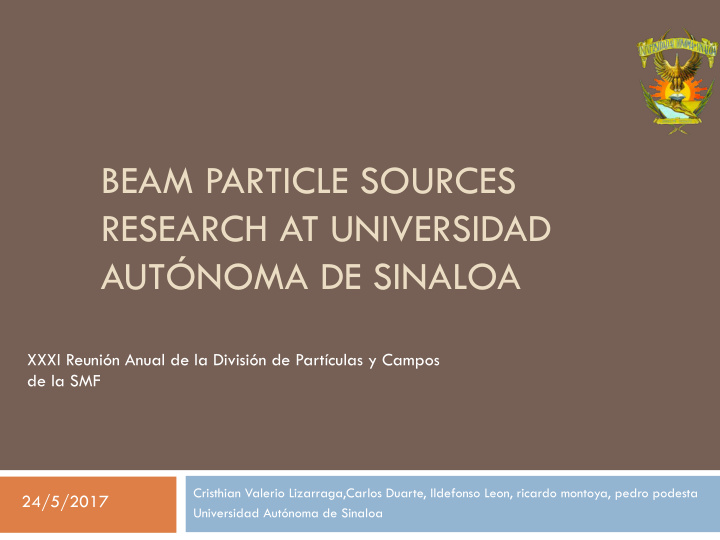



BEAM PARTICLE SOURCES RESEARCH AT UNIVERSIDAD AUTÓNOMA DE SINALOA XXXI Reunión Anual de la División de Partículas y Campos de la SMF Cristhian Valerio Lizarraga,Carlos Duarte, Ildefonso Leon, ricardo montoya, pedro podesta 24/5/2017 Universidad Autónoma de Sinaloa
Particle Sources • Several charged particle sources related research and projects are in progress at the University of Sinaloa(UAS). • The work can be divided into development of ion sources towards increase the beam intensity, Electron guns suitable for research an industrial applications.
Electron Linac RF Cavity ¨ An electron Linac is under design within the university ¨ Taking in to account the electromagnetic fields and mechanical constrains. ¨ Several CNC machines are ready to be used and milling the cavity parts
Simulations – 50Kev, 1 cavity 4 E*cos wt 1.2 1 0.8 0.6 0.4 0.2 0 0 0.5 1 1.5 2 Simulations Super Fish and IBsimu
200Kev, 1 cavity 5 Simulations Super Fish and IBsimu
Mechanical Design ¨ After design the cavities to resonate in the proper frequency a mechanical design is needed to put together the system 100 C Thermal Load in the ¨ Vacuum Tests in cavity Iris CINVESTAV
Workshop ¨ Thanks to CONACYT projects and the collaboration of Ildefonso Leon with Parque de innovacion tecnologica we have to our disposal a workshop to fabricate the parts
CERN COLLABORATION ¨ The collaboration with CERN is concerning two of the LHC Linacs ¨ Linac4 in the Source department ¨ Linac3 in beam dynamics and realistic simulations of Heavy ion beam transport
CERN donates RF ion source to UA Sinaloa Linac4 H - source prototype built by CERN-DESY collaboration , put into service in 2008; no longer used at CERN now ion components shipped to Mexico (estimated value 250 kCHF) (1) ceramic plasma chamber, (2) magnetic circuits, (3) RF antenna, (4) injection flanges with ignition gap, (5) ceramic isolation disks, and (6) front-end chamber Ion Source applications at the Universidad Autonoma de Sinaloa: boosting the training of students in producing charged particle beams, electronics for beam instrumentation and detector construction
Linac4 Source IOS-01 ¨ It deliver up to 20 mA of H- and 100 mA of protons. (máximum ion beam current in mexico 100 nA) ¨ The collaboration includes the the design of the missing equipment. ¨ In proton mode can achieve up to 50 KeV and 35 KeV in negative ions.
Beam Line
Linear Acelerator 3 (Linac3) ¨ The heavy ions are created in a ECR source Stripper Pb +53 Sol= Solenoide Diag=Diagnostic Chamber LIU - LHC Injectors Upgrade Project Quad=Quadrupole BCT=Beam Current Transformer R. Scrivens DetlefKuchler
Lead 29 ¨ The ion source deliver a beam that contains many species of particles O, C ,H,Pb ¨ To match the beam to the acceleration cavities the Pb 29 is the particle that we need to take from the source ¨ How?
Linac3 Spectrometer
Matrix and new simulation comparison Plane to compare the beam profiles
Instituto nacional de investigaciones Nucleares Ion Source • Snic Type Ion Source • Max Current 30 nA • Emittance ?
ININ Ion Source ¨ There are two ion Linacs at Instituto Nacional de Investigaciones Nucleares ¨ A profound research need to be done to increase the beam Ion source 3-D Simulation with intensity in the beam intensity at 50 nA source and improve the extend Vlasov equation used to solve the system of its research.
Conclusions ¨ With the acquired knowledge so far, it is possible to start small projects. ¨ There are outgoings collaborations related to accelerator physics between international institutes and Mexican universities ¨ SINALOA-CERN,LINAC4-LINAC3 ¨ SINALOA-CINVESTAV ¨ SINALOA-ININ ¨ • A closer collaboration with the industry is necessary to develop all the technology.
Thank you for your attention !!
General Description ¨ Electron Gun UAS ¨ Ion Source CERN-UAS ¨ Source UAS-ININ ¨ Summary
Steerer Solenoid Solenoid BCT Pre- RFQ Diagnostic Chopper Box with Ion Source Faraday Cup and Semgrid
Recommend
More recommend